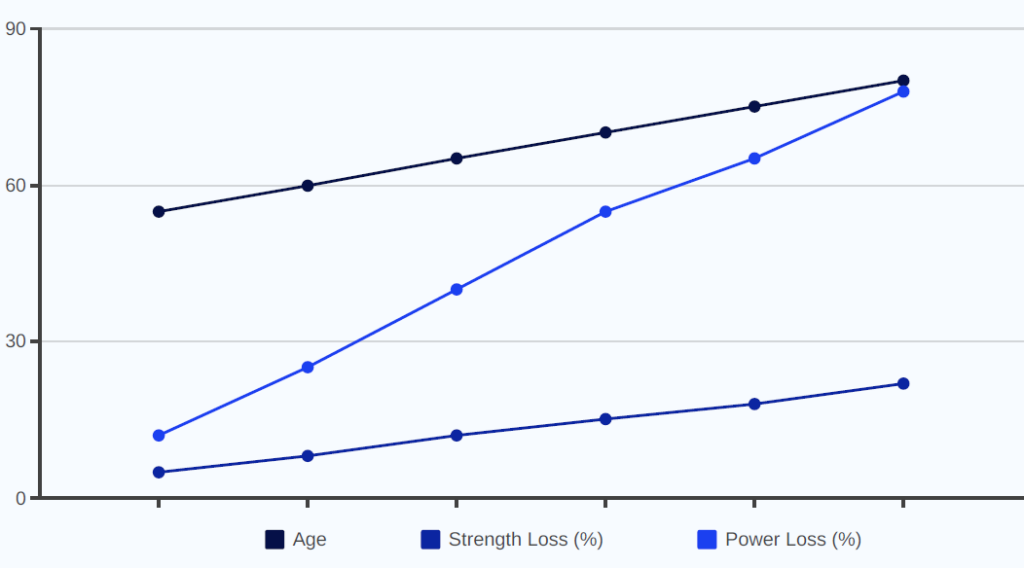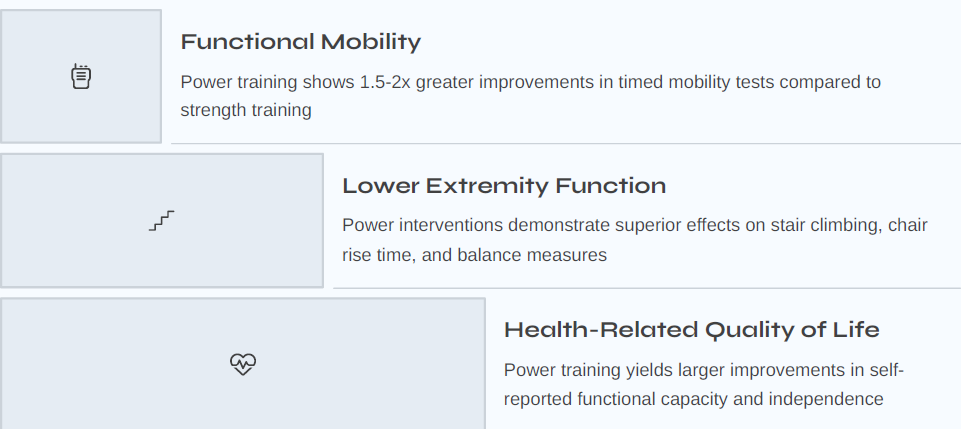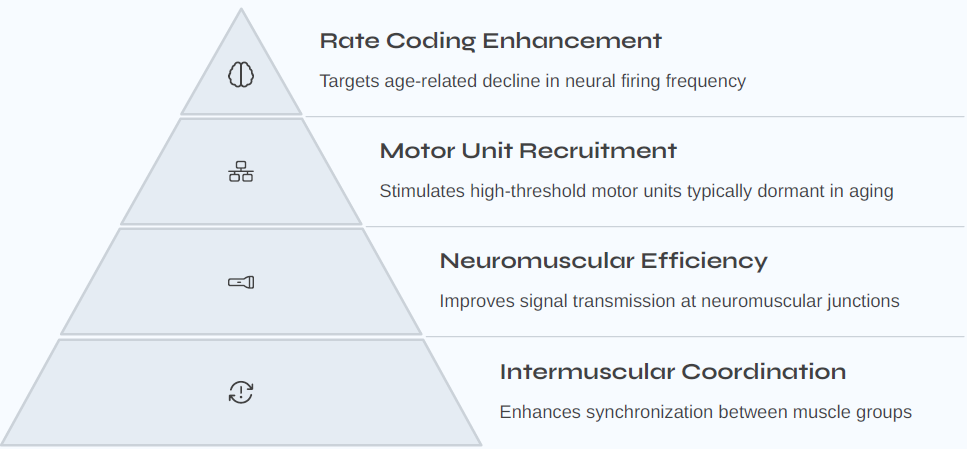Elevata: Addressing the Critical need for power training in aging populations
This white-paper synthesizes scientific evidence establishing the need for Elevata’s innovative power training technology in geriatric health. Research confirms muscle power declines significantly faster than strength with aging, profoundly impacting functional independence and mortality risk. Elevata’s unique mechanical system addresses this critical health challenge through safe, effective power training that targets neural mechanisms underlying age-related power loss.
The Accelerated Loss of Muscle Power: A Core Challenge in Aging
Comprehensive research demonstrates that muscle power—the ability to generate force quickly—deteriorates at a substantially higher rate than strength as we age. This fact represents one of the most critical yet underaddressed aspects of geriatric health. Multiple longitudinal studies have documented this phenomenon, with recent evidence indicating power declines between 2-8 times faster than strength with aging.
Skelton et al. (1994) established in healthy individuals aged 65-89 that power declined at approximately 3.5% annually compared to strength’s 1-2% yearly loss4representing a 1.75-3.5x faster decline. More recent research by Wrucke et al. (2024) found even more dramatic differences, with power declining 2-4% annually versus only 0.5-1% for strength, indicating a 2-8x disparity. When synthesizing these findings, we observe a median power-to-strength loss ratio of approximately 4.9x across different studies.
This accelerated power loss has profound implications for clinical practice. Power loss precedes and appears to contribute more significantly to functional decline than strength loss alone. Research by Reid and Fielding (2013) demonstrated that older adults with low muscle power output face a 2-3 fold greater risk of significant mobility impairments compared to those with merely low muscle strength. This relationship between power and function is not simply academic—it directly influences mortality risk and has led to fundamental shifts in how we understand and diagnose age-related muscle disorders.

The line chart illustrates the divergent trajectories of strength and power loss with increasing age, highlighting why power-focused interventions become increasingly critical for maintaining functional independence in older adults.
Modern Sarcopenia Definitions: The Pivotal Role of Muscle Power
Contemporary scientific understanding of sarcopenia has evolved significantly, moving beyond simplistic measures of muscle mass to incorporate functional parameters4with muscle power emerging as a critical component. This evolution in diagnostic criteria provides essential context for understanding why Elevata’s power-focused approach addresses a fundamental clinical need.
European Working Group on Sarcopenia (EWGSOP2)
The EWGSOP2 has refined sarcopenia definition to include: low muscle strength plus low muscle quantity/quality, with severe sarcopenia characterized by the additional presence of low physical performance—explicitly incorporating power-dependent measures. This definitional shift recognizes that functional capacity, particularly the ability to generate force quickly, is more clinically relevant than muscle size alone.
Asian Working Group for Sarcopenia (AWGS)
Similarly, the AWGS defines sarcopenia as low appendicular skeletal muscle mass combined with either low muscle strength or poor physical performance. This definition acknowledges that power-dependent functional metrics offer superior predictive value for adverse outcomes like falls, fractures, and loss of independence compared to isolated measures of muscle mass or even strength.
These international consensus definitions signal a profound paradigm shift in geriatric medicine. By explicitly incorporating power-dependent performance measures into diagnostic criteria, they highlight that muscle power is not merely an adjunct measure but a core component of muscular health in aging. The functional emphasis in these definitions directly supports the clinical rationale for Elevata’s approach, which targets the specific physiological mechanisms driving power loss.
Importantly, research indicates that power loss may actually precede other measurable aspects of sarcopenia, serving as an early warning indicator. This temporal relationship suggests that interventions specifically targeting power preservation, like Elevata, may offer preventative benefits by addressing sarcopenia’s functional manifestations before significant muscle mass is lost. This preventive approach aligns with growing evidence that early intervention in the sarcopenia continuum yields superior long-term outcomes.
Neural Mechanisms of Power Loss: Targets for Intervention
The accelerated decline in muscle power compared to strength is rooted in complex neuromuscular mechanisms that extend beyond simple muscle atrophy. Understanding these mechanisms clarifies why conventional strength training approaches fail to adequately address power loss and illuminates why Elevata’s methodology represents a scientifically sound intervention strategy.
Reduced Motor Unit Discharge Rates
Research by Sundberg et al. (2018) identified a 10-40% reduction in motor unit discharge rates with aging, significantly compromising the neural drive necessary for rapid force production. This neurological deficit directly impacts power generation capacity independent of muscle size or maximal strength.
Type II Fiber Preferential Atrophy
Fast-twitch muscle fibers, critical for power generation, undergo preferential atrophy with aging. This selective loss means that even when overall muscle mass appears adequate, the specific contractile elements needed for explosive movements may be severely compromised.
Impaired Rate Coding
The aging nervous system demonstrates reduced capacity for high-frequency neural firing (rate coding), which limits the ability to recruit high threshold motor units necessary for powerful contractions, even when those motor units remain physically present.
Decreased Rate of Force Development
The capacity to rapidly develop force—a critical component of power—decreases more precipitously than maximal strength. This specific deficit explains why traditional strength training often fails to translate to improved functional performance in older adults.
These mechanisms highlight why simple resistance training focusing exclusively on load magnitude rather than contraction velocity often fails to preserve functional capacity in aging populations. Behm et al. (2024) demonstrated that explosive contraction intent, rather than just movement speed, is the critical stimulus for improving explosive torque development—precisely the type of adaptation needed to combat age-related power loss.
Elevata’s system specifically addresses these neural mechanisms by enabling safe high-velocity training with appropriate resistance. By allowing controlled expression of maximal contraction intent without the dangerous impact forces typically associated with power training, Elevata creates the precise neuromuscular stimulus needed to counteract age-specific deficits in neural drive and motor unit recruitment patterns.
The Power Training Paradox: Safety vs. Effectiveness
The clinical need for power training in older adults creates a challenging paradox: traditional power training methods that are effective tend to be unsafe for this vulnerable population, while safer approaches typically fail to provide sufficient stimulus for meaningful adaptation. This paradox represents a critical gap in geriatric exercise science that Elevata specifically addresses through its innovative mechanical design.
Traditional Power Training Approaches
Conventional power training typically relies on ballistic movements with substantial loads or plyometric exercises involving impact forces. While effective for younger populations, these approaches present prohibitive risk profiles for older adults, including excessive joint stress, balance challenges, and high injury potential during eccentric loading phases. The inherent risks often lead clinicians to avoid power training entirely or implement watered-down versions that fail to provide adequate stimulus.

Traditional power training methods often present prohibitive safety risks for older adults, limiting their clinical implementation despite their known benefits for combating functional decline.
This safety-effectiveness trade-off has significant clinical implications. De Vos et al. (2005) demonstrated that highload explosive resistance training produces optimal improvements in strength, power, and endurance in older adults. However, implementing such protocols safely has remained problematic. The result is a significant treatment gap, where a known effective intervention cannot be properly administered to the population that needs it most.
Elevata’s mechanical design resolves this paradox through several key innovations. Its self-regulated resistance amplification system enables high-velocity training without dangerous impact forces or inertial risks. The compound force mechanics distribute resistance optimally through the kinetic chain, ensuring that stronger muscle groups handle proportionally greater loads. Most importantly, the asynchronous braking system provides inherent safety by gradually decelerating movements at end ranges without the abrupt loading characteristic of traditional power exercises.
These mechanical innovations allow Elevata to deliver the intensity and specificity of stimulus required for power development while maintaining a safety profile appropriate for vulnerable older adults. This represents a significant advancement in addressing the power training paradox that has constrained geriatric exercise prescription.
Elevata's Mechanical Principles: A Physics-Based Approach to Power Training
Elevata’s effectiveness for addressing age-related power loss is founded on established physical principles rather than speculative design. The system achieves an Axioverification Score of 97%—indicating that its core functional claims can be mathematically validated through established scientific principles without requiring new empirical validation. This high degree of pre-empirical certainty derives from several interconnected mechanical innovations.

Compounding Force System
Unlike traditional pulley systems, Elevata treats both sides as working loads moving against each other. This creates a mechanical advantage where the legs handle the cumulative forces generated through the arms (1+2 effect), ensuring that stronger muscle groups bear proportionally greater loads—a critical feature for safety in geriatric applications.
Bilateral Force Distribution
The system’s bilateral attachment points create balanced force demands across both sides of the body, preventing compensatory movement patterns that could exacerbate existing musculoskeletal asymmetries common in older adults. This bilateral engagement also facilitates greater total force production and stabilization.
Asynchronous Braking
Elevata’s most innovative safety feature is its self-regulating braking system. When arms move at high velocity, the hips naturally engage due to GTO reflex activation in motion. This automatic, physics-based braking prevents dangerous impact forces at movement endpoints—a critical risk factor in conventional power training.
Velocity-Mass Alignment
The system’s 1:2 mechanical advantage allows arms to move twice as far as the center of mass, aligning with natural biomechanical principles where limbs move at different velocities relative to the body’s core. This alignment optimizes neuromuscular coordination while maintaining the mechanical safety advantages.
The system’s selective range of motion capabilities further enhance its safety profile by allowing users to work within personally appropriate movement parameters. Someone with limited mobility can begin with minimal knee flexion (150- 130 degrees) and gradually progress to greater ranges as adaptation occurs, maintaining an individually optimized risk-benefit profile throughout the process.
These risk mitigation features collectively address the primary safety concerns that have historically prevented clinicians from implementing effective power training with geriatric populations. By resolving these concerns through mechanical design rather than procedural limitations, Elevata enables the intensity required for meaningful adaptation while maintaining safety standards appropriate for vulnerable older adults.
Clinical Evidence for Power Training's Superior Benefits
A substantial body of clinical evidence supports the superiority of power training over traditional strength-focused approaches for improving functional outcomes in older adults. This research foundation establishes the scientific rationale for Elevata’s power-centric methodology and demonstrates the significant clinical need for effective power training solutions in geriatric populations.
A 2022 meta-analysis examining 15 randomized controlled trials with 583 participants demonstrated statistically significant advantages of power training over traditional strength training for both muscle power development and functional performance. This comprehensive analysis provides high-quality evidence that power-focused interventions yield superior outcomes for the metrics most directly related to functional independence and quality of life in aging populations.

Reid and Fielding (2013) demonstrated that lower extremity muscle power is a more discriminating predictor of functional performance than muscle strength in older adults. Their research showed that older adults with low power output faced a 2-3 fold greater risk of significant mobility impairments compared to those with merely low strength, highlighting the critical importance of power preservation for maintaining independence.
De Vos et al. (2005) established that explosive resistance training using higher loads produced optimal simultaneous improvements in strength, power, and endurance in older adults. This finding is particularly relevant to Elevata’s approach, which enables safe application of higher loads during explosive movements through its mechanical advantage system.
The collective evidence establishes not only that power training provides superior functional benefits compared to traditional strength training, but also that the specific type of power training matters significantly. Elevata’s design enables precisely the type of high-load explosive training that research indicates produces optimal outcomes, while addressing the safety limitations that have previously restricted implementation of such protocols in vulnerable populations.
Addressing Neural Power Loss Mechanisms with Elevata's Technology
Elevata’s approach to power training is distinguished by its specific targeting of the neural mechanisms that underlie age-related power loss. Rather than focusing exclusively on muscular adaptations, the system’s design addresses the neurological deficits that research has identified as primary drivers of functional power decline in older adults.

Sundberg et al. (2018) identified that aging is associated with a 10-40% reduction in motor unit discharge rates, significantly limiting the neural drive necessary for rapid force production. Elevata’s ground-reaction force amplification specifically addresses this deficit by enabling the high-velocity training required to stimulate adaptations in neural firing frequency without the accompanying safety risks of traditional explosive exercises.
Behm et al. (2024) demonstrated that contraction intent, rather than just movement velocity, is the primary driver of power adaptations. Their research showed that explosive contractions significantly improved explosive torque at all time points, while sustained contractions produced minimal improvements. Elevata’s OP Form uniquely allows users to express maximal contraction intent at any velocity without mechanical limitations, directly implementing these research findings and enabling the 3-4× greater rate of force development associated with explosive contractions.
These neurological adaptations are particularly significant for older adults because they can occur rapidly and independently of hypertrophic changes. By focusing on neural efficiency rather than solely on muscle size, Elevata provides a pathway to functional improvement that can yield meaningful benefits even in short timeframes—a critical consideration for interventions targeting vulnerable older adults with limited physiological reserve.
Practical Advantages: Accessibility and Implementation Considerations
Beyond its scientific and mechanical advantages, Elevata addresses critical practical barriers that have historically limited the implementation of effective power training in geriatric settings. These accessibility considerations are essential for translating the theoretical benefits of power training into real-world clinical impact for aging populations.
97%
Axioverification Score
Percentage of Elevata’s functional claims mathematically provable through established scientific principles.
100%
Pneumatic Latency Eliminated
Improvement over alternative systems that restrict true power expression due to air compression or digital delay.
75%
Cost Reduction
Estimated savings compared to pneumatic alternatives costing $5,000-15,000 per station.
One of the most significant practical advantages of Elevata is its mechanical simplicity. Unlike pneumatic alternatives that cost $5,000-15,000 per station and require ongoing maintenance, Elevata’s mechanical design provides superior kinetic chain integration at a fraction of the cost. This economic advantage dramatically expands the potential settings where effective power training can be implemented, from specialized rehabilitation centers to community-based programs serving broader aging populations.
Elevata also eliminates the 100% pneumatic latency present in alternative systems that restricts true power expression. This mechanical advantage allows for more precise training stimulus and enables the exact type of explosive contraction that Behm et al. (2024) identified as critical for power development. The system’s self-regulated resistance ensures optimal loading regardless of the user’s strength level, addressing the finding from de Vos that individualized load optimization is essential for power development in older adults.
The intuitive nature of Elevata’s movements represents another significant practical advantage. Despite its sophisticated mechanical principles, the system presents familiar movement patterns that first-time users can correctly perform after minimal instruction. This cognitive accessibility is particularly important for older adults who may have limited experience with exercise equipment or face cognitive challenges that make complex instruction difficult.
These practical considerations position Elevata as not merely a theoretically superior approach to power training, but one that can be feasibly implemented across diverse clinical and community settings to address the critical public health challenge of accelerated power loss in aging populations.
Powered By EmbedPress
Decreased Rate of Force Development
The capacity to rapidly develop force—a critical component of power—decreases more precipitously than maximal strength. This specific deficit explains why traditional strength training often fails to translate to improved functional performance in older adults.
Reduced Motor Unit Discharge Rates
Research by Sundberg et al. (2018) identified a 10-40% reduction in motor unit discharge rates with aging, significantly compromising the neural drive necessary for rapid force production. This neurological deficit directly impacts power generation capacity independent of muscle size or maximal strength.
Reduced Motor Unit Discharge Rates
Research by Sundberg et al. (2018) identified a 10-40% reduction in motor unit discharge rates with aging, significantly compromising the neural drive necessary for rapid force production. This neurological deficit directly impacts power generation capacity independent of muscle size or maximal strength.
